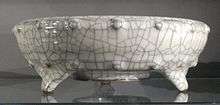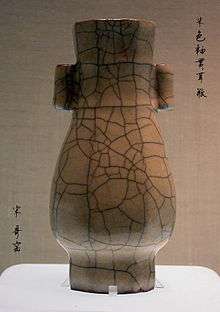Five Great Kilns

The Five Great Kilns (Chinese: 五大 名窯, Wu da ming yao), also known as Five Famous Kilns, is a generic term for ceramic kilns or wares (in Chinese 窯 yao can mean either) which produced Chinese ceramics during the Song dynasty (960-1279) that were later held in particularly high esteem. The group were only so called by much later writers under the Ming and Qing dynasties, and of the five, only two (Ru and Guan) seem to have produced wares directly ordered by the Imperial court, though all can be of very high quality. All were imitated later, often with considerable success.[1]
The five kilns produced respectively:
-

Ru ware bowl, with metal rim, 1086-1125
-

Small Guan ware bowl on legs (some 3 inches across), with pronounced glaze crackle, Southern Song
-
_with_Garden_Landscape_LACMA_M.73.48.106.jpg)
Ding ware dish with garden landscape, "molded stoneware with impressed decoration, transparent glaze, and banded metal rim", 13th century, diameter 5.5 in. (14 cm)
-

"Ge-type" or ge ware vase, with double crackle, dated by the Palace Museum Beijing to the Song
References
- ↑ Rawson, 246
- Rawson, Jessica (ed). The British Museum Book of Chinese Art, 2007 (2nd edn), British Museum Press, ISBN 9780714124469
